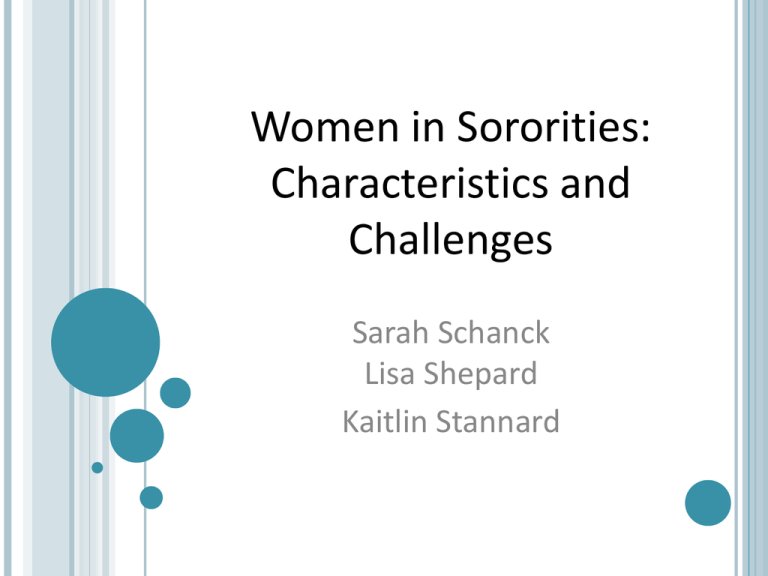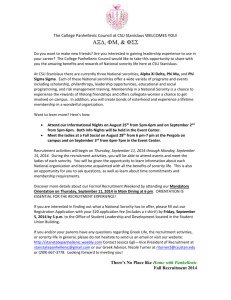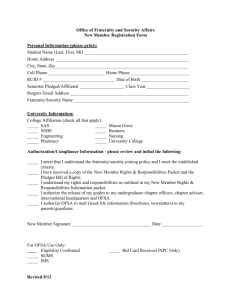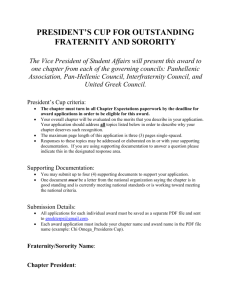Group Project PowerPoint Presentation
advertisement

Women in Sororities: Characteristics and Challenges Sarah Schanck Lisa Shepard Kaitlin Stannard Overview • Positive associations of sorority affiliation • Negative associations of sorority affiliation • Trends affecting the subpopulation • Leadership development • Service and scholarship • National organizations: National Panhellenic Conference (NPC), National Pan-Hellenic Council (NPHC), and Multicultural Positive Associations of Sorority Affiliation • 9 million college students are members of a Greek organization • Can help improve interpersonal skills and leadership capabilities • Learn to respect diverse perspectives • Common rituals and alumni network • Positive community interaction and philanthropy Negative Associations of Sorority Affiliation • Hazing • Binge drinking and alcohol abuse • Body image and eating disorders • Sexual abuse • Perceived lack of diversity “Unfortunately we all know people that wear letters and aren’t interested in the right kind of membership” Trends Affecting Subpopulation • Research tends to focus on negative issues instead of positive influences of affiliation • Values based marketing needs to be incorporated • Increased media pressure over hazing and diversity issues “There is an ever-increasing gap between the founding principles of fraternities and sororities and the reality of their current state.” Leadership Development • Values based skill building • Citizenship through community engagement • Opportunities to lead peers and fail in a nurturing environment • Gains in social development • Indirect impact on cognitive ability • Increased engagement with university Service and Scholarship • Higher retention rates for sorority women vs. non-sorority women • Increased exposure to diverse perspectives • More likely to donate time or money to civic or religious organizations • Positive correlation between this type of engagement and lifelong learning • All organizations have a service connection and a scholarship requirement National Panhellenic Conference • 26 member organizations • Vision Statement: Advancing the Sorority Experience Together Click to edit the Kappa Alpha Theta outline text format Pi Beta Phi Kappa Kappa Gamma Second Outline Alpha Gamma Delta Level Delta Gamma Gamma Phi Beta • Mission Statement: The National Panhellenic Conference is the premier advocacy and support organization for the advancement of the sorority experience. Alpha Chi Omega Alpha Xi Delta Delta Delta Delta Chi Omega Sigma Kappa Alpha Omicron Pi Zeta Tau Alpha Third Outline Level Fourth Outline Level Fifth Outline Level Values of the NPC THE PANHELLENIC CREED We, as Undergraduate members of women’s fraternities, stand for good scholarship, for guarding of good health, for maintenance of fine standards, and for serving, to the best of our ability, our college community. Cooperation for furthering fraternity life, in harmony with its best possibilities, is the ideal that shall guide our fraternity activities. We, as Fraternity Women, stand for service through the development of character inspired by the close contact and deep friendship of individual fraternity and Panhellenic life. The opportunity for wide and wise human service, through NPC Student Perspective Sydney Jessup- ADPi at Georgia College “Alphato Delta Pi has greatly improved Click edit the my college experience as well as my outline text format life! I have gained so much from this organization from the friendships to experiences. Second Outline It has opened my eyes toLevel the meaning of being a part of something more. This organization Third hasallowed meOutline to volunteer from servingLevel others to fundraising. It has also allowed for many networking Fourth opportunities with alumni and those attending our events. Although it is Outline time consuming, the experience of Level being part of this sisterhood has truly enhanced mylife. I would not trade Fifth this experience for the world. “ Outline Level National Pan-Hellenic Council (NPHC) On May 10, 1930, on the campus of Howard University, the National Pan-Hellenic Council was formed. It is composed of 9 Greek letter organizations known collectively as the "Divine Nine." Alpha Phi Alpha Fraternity, Alpha Kappa Alpha Sorority, Kappa Alpha Psi Fraternity, Omega Psi Phi Fraternity, Delta Sigma Theta Sorority, Phi Beta Sigma Fraternity, Zeta Phi Beta Sorority, Sigma Gamma Rho Sorority and Iota Phi Theta Fraternity make up what is known as the National Pan-Hellenic Council. Alpha Kappa Alpha was the nation’s first African-American sorority. It was founded at Howard University in 1908. National membership is estimated at 260,000. The nation's second-oldest African-American sorority, Delta Sigma Theta, was also founded on the campus of Howard University in 1913. It has a national membership of over 250,000. Zeta Phi Beta Sorority was founded in 1920 at Howard University, as well. It’s membership is estimated at 125,000. NPHC Purpose and Mission The stated purpose and mission of the Politics: Day at the Click AKA to edit the outline text format NPHC in 1930 was, “Unanimity of thought Capitol and action as far as possible in the conduct Education: Delta GEMS of Greek letter collegiate fraternities and (Growing and Empowering Myself Third Outline Successfully) sororities, and to consider problems of mutual interest to its member organizations. Today, the NPHC National Initiatives Program details the service projects of the NPHC nine member organizations in the Second Outline Level Level Economics: Sigma Gamma Fourth Rho and Re/Max Home Outline Level Ownership Partnership Fifth Environment: Project ZETA Outline Level (Zeta Environmentalist Teaching Activism) As evidenced by the universities on which the four African-American sororities in the NPHC were founded, college women can experience Greek life on the campuses of either historically Black college and universities (HBCUs) or predominantly White institutions (PWIs). TABLE 2 Regression Summaries for the Effects of Greek Affiliation on Student Engagement Student Engagement Metric Regression Coefficient Effect Size R2 Part A: All African American Students Academic challenge .309 .055 .062 Active and collaborative learning . .586* .163 .122 Student-faculty interaction .711* .205 .085 Supportive campus climate .437 .089 .041 Part B: HBCU Students Academic challenge .759 .134 .073 Active and collaborative learning .693* .189 .121 Student-faculty interaction .834* .230 .104 Supportive campus climate .411 .082 .037 NPHC Challenges… continued Research on student engagement is abundant. However, student engagement research that focuses on Black student Greek affiliation is limited. The information that is available shows that HBCU attendance results in positive effects on many educational outcomes for students. The results of the research by Patton, Bridges, and Flowers reflected in the regression summaries shown in Table 2 reflect that African-American students in fraternities and sororities at HBCUs are more engaged in effective educational practices than African-American students in sororities and fraternities at PWIs. Therefore, the NPHC will continue to be challenged with increasing the engagement of African- American women in sororities at PWIs and maintaining the viability of those sorority chapters. National Multicultural Greek Council • Member Sororities 12 member organization • – 9 Sororities – 3 Fraternities Click to edit the Delta Xi Phi outline text format Delta Sigma Chi Second Outline Level Gamma Eta Formed in 1998 to unite Greek-letter Fraternities and Third Sororities under one national entity, the NMGC provides in an advisory capacity to its autonomous Greek-letter Level organizations. • Mission and Purpose – Provide a forum for the free exchange of ideas, programs, and services between multicultural Greek societies. – Promote the awareness of multicultural diversity within collegiate institutions, local community, and Outline Theta Nu Xi Lambda Psi Delta Fourth Outline Lambda Tau Omega Level Mu Sigma Upsilon Fifth Omega Phi Chi Outline Level Lambda Sigma references Alpha Delta Pi. (2008). Retrieved from: ttp://www.alphadeltapi.org/contentmanager/page.asp?webpageid=1 Barker, C. (2010, February 18). Who are the Black Greeks and why?. New York Amsterdam News. p. 17. Delta Xi Phi National Sorority. (2013). About. Retrieved from http://deltaxiphi.com/about/. Glass, N. (2012). Examining the benefits of greek life. USA Today College. Retrieved from: http://www.usatodayeducate.com/staging/index.php/campuslife/examining-the-benefits-of-greek-life National Multicultural Greek Council. (2013). The constitution of the national multicultural greek council. Retrieved from http://nationalmgc.org/about/constitution/. National Panhellenic Conference. (2012). 2011-2012 Annual report. Retrieved from: https://www.npcwomen.org/resources/pdf/2012%20Annual%20Report.pdf National Panhellenic Conference. (2013). Unanimous Agreements. Retrieved from: https://www.npcwomen.org/resources/pdf/Unanimous%20Agreements.pdf National Pan-hellenic Council, Incorporated. (2010). Mission. Retrieved from: http://www.nphchq.org/mission.htm National Pan-hellenic Council, Incorporated. (2010). National program initiatives. Retrieved from: http://www.nphchq.org/docs/NPHC_Program_Initiatives_2010.pdf National Pan-hellenic Council, Incorporated. (2010). Leadership. Retrieved from: http://www.nphchq.org/leadership.htm





